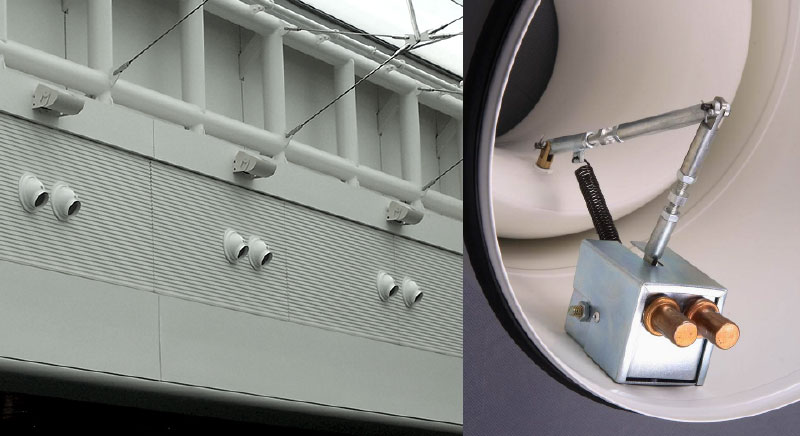With the SG-186 project and the subsequent proposal of SG-EPR, the construction and development of intelligent communication information platform, the explosive growth of power data, the existing power data center processing huge data efficiency is not high, can not meet the needs of power users, that is, the quality of service (QoS) is not guaranteed. Through the analysis of power data center and the study of SDN, the practicability of SDN for power data center is explained. SDN is reasonably applied to power data center.
On this basis, an optimization scheme is proposed. Finally, simulation test is carried out on mininet experimental platform. As the carrier of power industry informationization, power data center mainly provides the ability of information analysis, processing and storage. It is the core infrastructure of power information technology services to ensure the continuous, reliable and safe operation of power information system business. With the advent of Internet of Things technology, the scale of power data center is expanding and the system is becoming more and more complex, which makes the number of hardware and software devices such as optical fiber switch, network equipment, server, security equipment, access switching and convergence switching equipment involved in power data center become larger and larger. At the same time, SG-EPR service is in power data center.
Deployment increases the types and quantity of business, and the huge data volume of disaster preparedness business of information system will occupy a larger bandwidth.

Finally, from the data of recent years, it seems that the power data center has a higher stability and to ensure the reliability of power supply, energy consumption is also generally improved.
In view of these problems in traditional power data center, many scholars and experts are thinking about solutions, especially the emergence of large data and cloud computing in recent years, which can improve the system of power data center. Software Definition Network (SDN) has attracted much attention since it was listed in the top ten frontier technologies in 2009. The deployment of SDN network is realized by software definition.
Its essential attributes are the separation of control and forwarding, open programming interface and centralized network control. SDN makes the network management more convenient and flexible, realizes the automatic deployment of business, improves the utilization of resources, reduces the cost of network construction and maintenance, and promotes the innovation of network business.

The idea of SDN conforms to the requirements of simple, open, programmable and scalable network, and has been strongly supported by academia and industry. It is considered as the direction of network development and has become a hot technology in the industry in recent years. SDN is a new network technology, which separates the control plane from the data forwarding plane in the transmission network and pushes it into the centralized controller. SDN centralized control mode shields the difference of physical equipment and realizes programmable control of network through North-South interface. SDN technology is applied to power data center, and power data center system is defined by software. Its main functions and advantages include: (1) centralized and efficient management and operation of data center network; (2) multi-path forwarding; (3) intelligent virtual machine deployment and migration; (4) efficient resource allocation and flexible scheduling. The classical three-tier architecture is shown in Figure 1, and the basic architecture of SDN is shown in Figure 2. SDN system architecture of power data center draws lessons from the popular three-tier architecture in the industry. The bottom layer uses general forwarding plane to construct physical bearer network, and the south side uses adapted interfaces supporting heterogeneous devices access and evolution-oriented. At present, the mainstream OpenFlow south-facing interface protocol network operating system supports unified control of decentralized resources, and the bearer layer realizes fast perception and docking of power services, and the north side supports power applications.
Layer platform provides simple and flexible user interface for managers. The SDN system architecture of power data center is shown in Figure 3. SDN controller is the core of SDN architecture and the control center of SDN system. Its function directly affects the whole SDN network, and is also the premise of large-scale application of SDN. We divide the controller into different layers: at the bottom, we call it the south-facing interface layer. There are different data protocols such as OpenFlow, NetConf/XMPP, BGP, etc. Because the controller manages different nodes downstream, and these different vSwitches or physical switches use different protocols. The second layer is the SAL adaptation layer, which shields the difference of interface between different manufacturers or different devices to provide southbound interface, so that the upper module can run only for the business processing he cares about, without caring about the difference between APIs of different manufacturers. Further up is the basic network function modules and built-in applications, the most critical calculation is completed by the Overlay module. Next up is the northward interface layer, which means that the programmable controller should provide a good programming interface to the outside world. Finally, there is a part of management, which includes software management, software upgrade, thermostatic element add modules, life cycle management, cluster management and some UI interfaces. The logic level of the controller is shown in Figure 4. There is an SDN controller in SDN architecture, but if SDN is applied to the power data center to process huge data, the single-node controller must be inefficient, or if such a controller exists, the cost will be very high, and the reliability will be poor. Once attacked, the whole system will be affected. System operation. The basic architecture of single controller control is shown in Figure 5. Aiming at the drawbacks of single controller, we optimize it and deploy it in the way of controller group. One of them is the main controller and the other is the sub-controller. The main controller provides northward access interface to the upper controller and manages the control group. The sub-controller is responsible for the management and control of the switch and the company. The way to connect the switch is the south-facing interface. Placing all the main controllers in one area as the main control group and the others as backups keeps the control group having a continuous and uninterrupted ability to provide northbound interfaces to the outside world. The following sub-controllers are divided into one area. There are more than one sub-controllers in one area. Exchange opportunities are connected to all sub-controllers in one area. One sub-controller in one area is selected as the main controller. Such a switch has multiple sub-controllers.
If the main one is down, the switch After discovery, you can choose a new one from the rest, ready to become the master, so that you can provide an uninterrupted service capability and improve reliability. As shown in Figure 6.
All of these controllers can realize data sharing and real-time backup. When the business data of a controller changes, its data will be stored in the database. Aiming at the problem of SDN single controller, the optimized deployment of SDN single controller can greatly improve its security performance, improve the reliability of the whole data center, prevent the security problem of attacking the main controller, at the same time, multiple controllers can also improve the efficiency of the data center and multiple controllers are single controllers. Comparatively speaking, the cost of the simplified controller group is also reduced.
